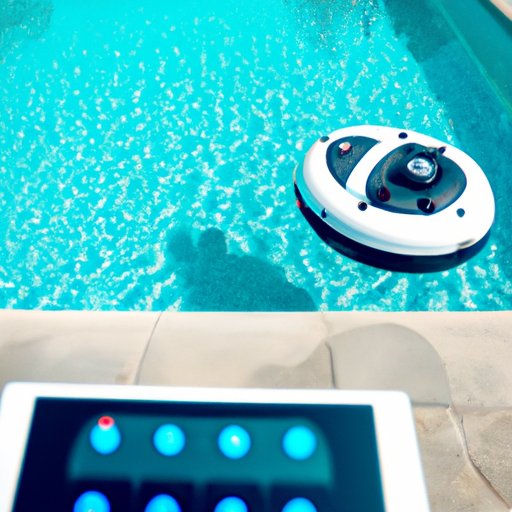Introduction
A robotic pool cleaner is a machine that is used to clean swimming pools. These machines are designed to move around the pool, scrubbing and vacuuming debris from the walls and floor of the pool. They are usually powered by electricity and are programmed to follow a predetermined path, allowing them to clean the entire pool without the need for manual intervention. In this article, we will explore how a robotic pool cleaner works, the benefits of using one, the latest advances in robotic pool cleaner technology, and how to troubleshoot common problems.
A Step-by-Step Guide to Understanding How a Robotic Pool Cleaner Works
Robotic pool cleaners are comprised of several components, all of which work together to clean the pool. The most important components are the motor, filter, and drive system. The motor powers the robot and is responsible for propelling it around the pool. The filter collects debris as the robot moves around the pool, while the drive system allows the robot to maneuver around obstacles and navigate through tight spaces.
Robotic pool cleaners come in a variety of different types, each with its own unique features and capabilities. Some are programmed to clean the entire pool automatically, while others require manual intervention to guide them along certain areas. Additionally, some robotic pool cleaners have additional features such as spot cleaning, navigation systems, and waterline scrubbers.
An Examination of the Benefits of Using a Robotic Pool Cleaner
Using a robotic pool cleaner can offer a number of advantages over traditional methods of pool cleaning. One of the biggest benefits is improved cleaning efficiency. Robotic pool cleaners are designed to clean the entire pool quickly and effectively, meaning less time spent manually vacuuming and scrubbing. This can result in significant cost savings in terms of both labor and energy.
In addition to improved efficiency, robotic pool cleaners can also help reduce labor costs. Because they require minimal human intervention, they can be operated with fewer staff members, resulting in lower overall costs. Furthermore, robotic pool cleaners are much safer than traditional methods of pool cleaning, as they don’t rely on people being in the pool.

Exploring the Latest Advances in Robotic Pool Cleaner Technology
In recent years, there have been a number of advances in robotic pool cleaner technology. Automation technology has allowed robotic pool cleaners to become more efficient and accurate, while advanced sensors allow them to detect and avoid obstacles. Additionally, some models now feature smartphone control, allowing users to control the robot remotely.
These advances in technology have made robotic pool cleaners more effective and user-friendly than ever before. By leveraging the latest advancements in robotics, these machines are now able to provide a faster, more efficient way to keep swimming pools clean.

Troubleshooting Common Issues with Robotic Pool Cleaners
Like any piece of machinery, robotic pool cleaners can sometimes experience problems. Fortunately, there are a few basic troubleshooting techniques that can help identify and resolve common issues. For example, checking the power source, inspecting the filter, and ensuring the robot is properly aligned are all good starting points.
Other common problems include clogged filters, stuck motors, and faulty sensors. If these issues occur, it is important to take the necessary steps to resolve them. For instance, a clogged filter can be cleared by backwashing or replacing the filter cartridge, while a stuck motor can be reset by disconnecting the power source and then reconnecting it.
Conclusion
Robotic pool cleaners are an effective and efficient way to keep swimming pools clean. In this article, we explored how a robotic pool cleaner works, the benefits of using one, the latest advances in robotic pool cleaner technology, and how to troubleshoot common issues. Overall, robotic pool cleaners can save time, money, and effort when it comes to keeping your pool clean.
By understanding how robotic pool cleaners work and taking advantage of the latest advances in technology, you can ensure that your pool remains clean and safe for years to come.
(Note: Is this article not meeting your expectations? Do you have knowledge or insights to share? Unlock new opportunities and expand your reach by joining our authors team. Click Registration to join us and share your expertise with our readers.)
